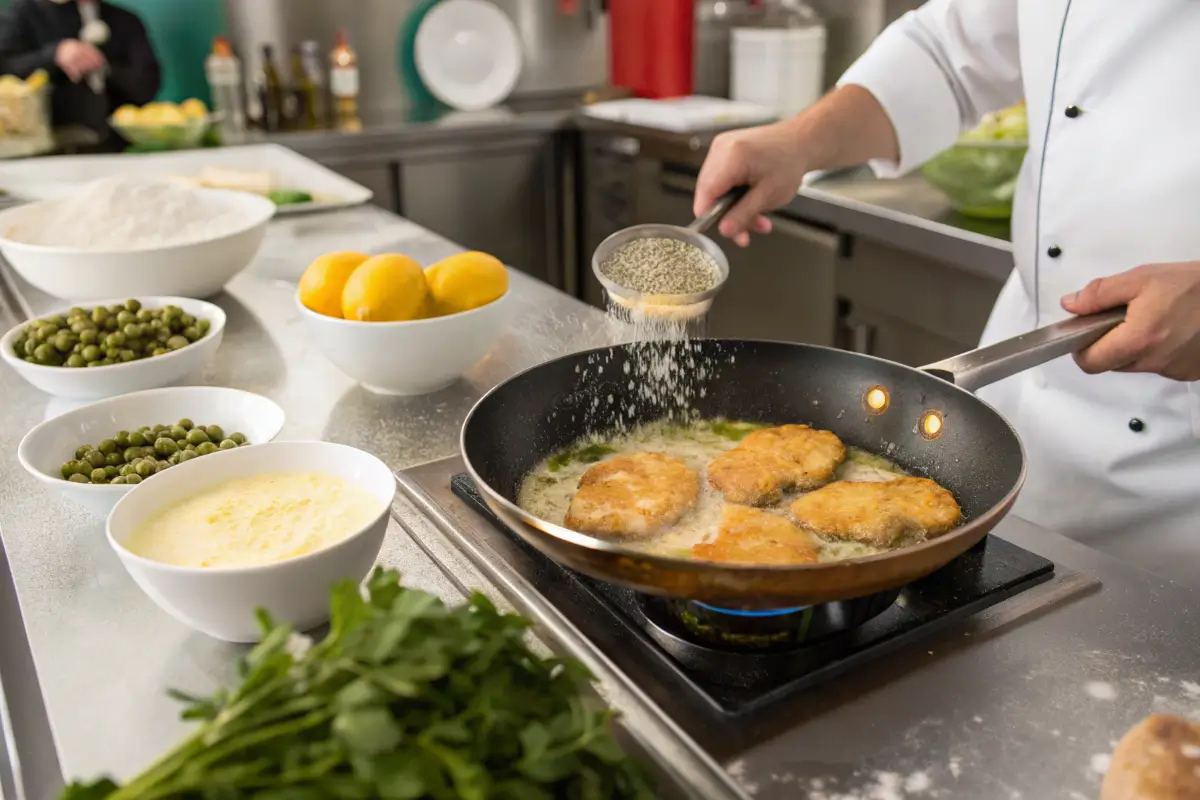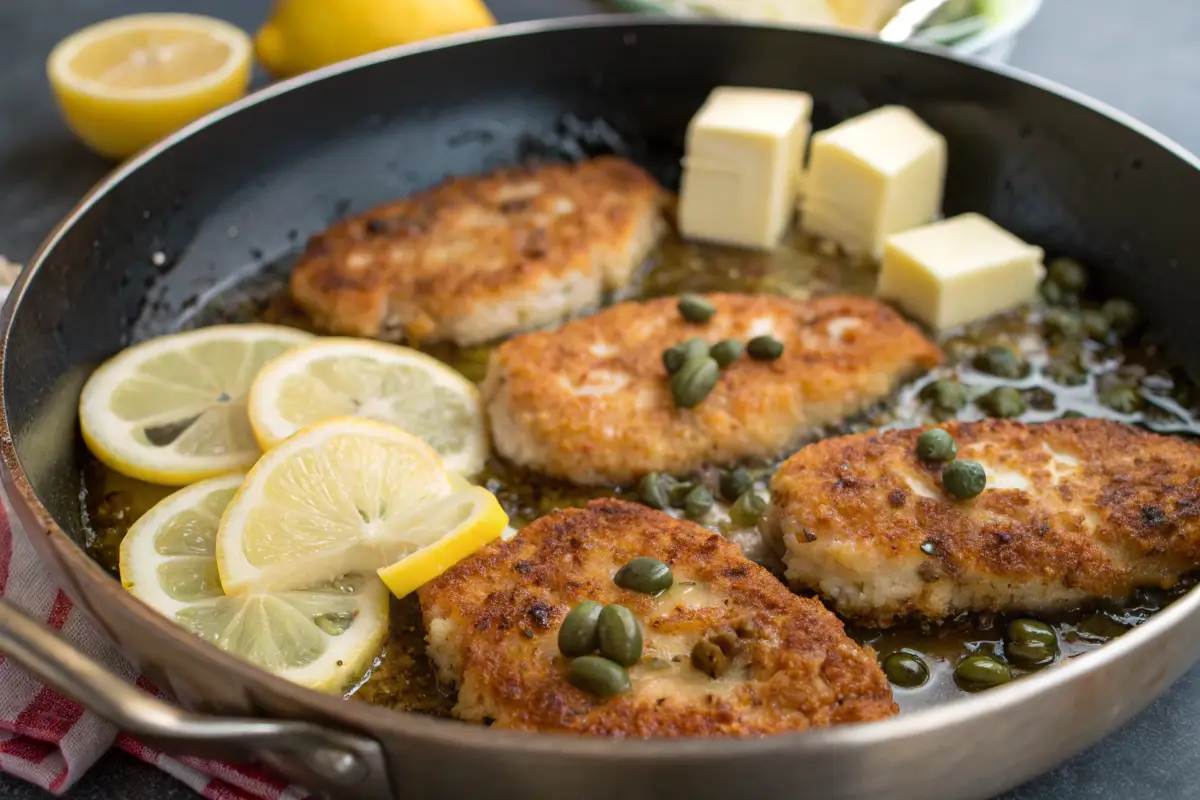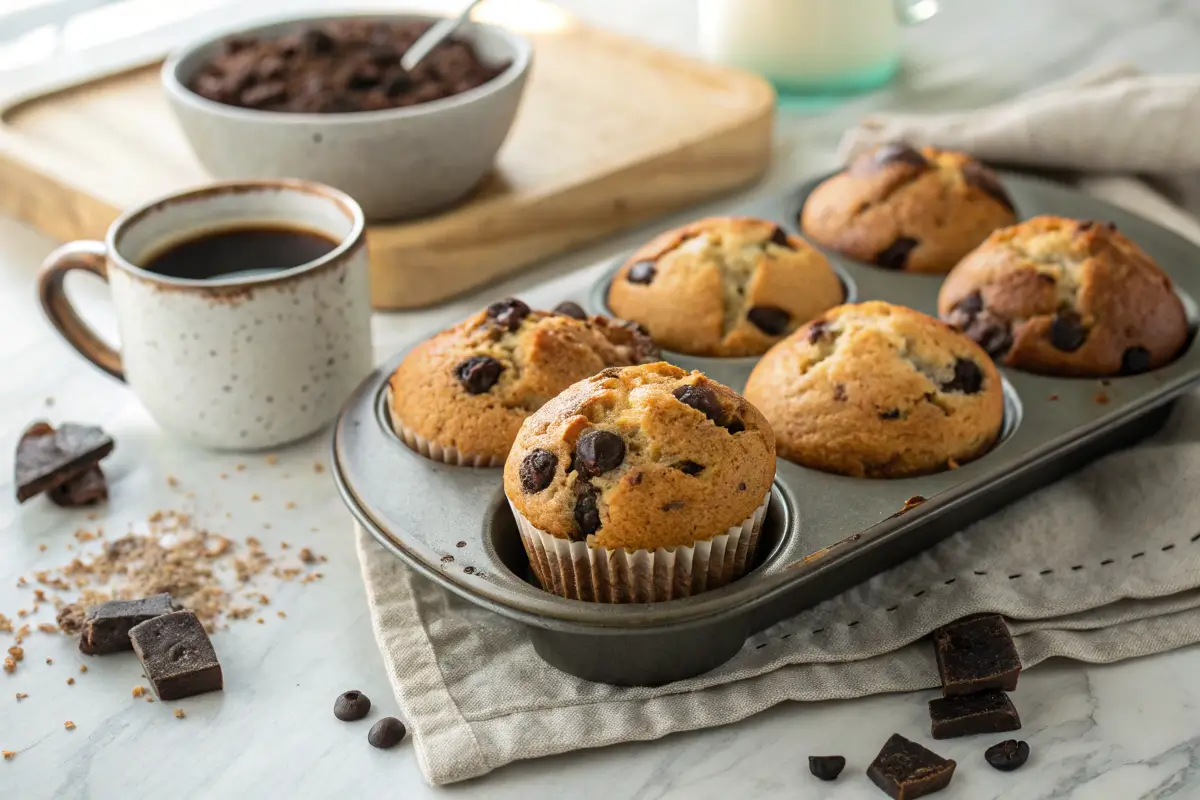Ever wonder Is chicken francese the same as Piccata? Perhaps you’ve tried both dishes at your favorite Italian-American restaurant and found yourself puzzled by their tantalizingly similar flavors. In truth, these two lemony chicken preparations share a host of similarities—like a velvety white wine sauce and a succulent pan-fried chicken cutlet—yet they’re not entirely identical.
Throughout this article, we’ll explore their unique traits, dive into their fascinating heritage, and learn how they evolved into beloved staples of Italian-American cuisine. Additionally, we’ll walk through specific cooking methods, health tips, practical substitutions, and more.
You’ll discover why each dish has its own devoted following, and which one might become your go-to recipe for an easy weeknight meal. Ready to unravel their flavorful backstories? Let’s jump right in.
Origins and History of Chicken Francese and Chicken Piccata
Tracing the Roots of Chicken Francese
Chicken Francese, also known as “Chicken Française,” traces its lineage to the Italian and Italian-American culinary tradition. Interestingly, it’s often viewed as an egg-dipped chicken creation that gained popularity in the United States rather than in Italy itself.
Many credit the dish’s birth to enterprising immigrant chefs who wanted to adapt homestyle recipes for the American palate. Consequently, fried chicken cutlets—flour-dredged and dipped in an egg mixture—became a signature technique that gave this recipe its classic crispy golden exterior.
Furthermore, the addition of white wine sauce and butter delivered that luscious finish now associated with every Chicken Francese plate.
How Chicken Piccata Came to Be
Piccata, by contrast, hails straight from traditional Italian chicken recipes, although it can also be made with veal or fish. The word “piccata” itself indicates a slicing or flattening technique, reflecting how the meat is prepped before cooking. Over time, Italians in different regions created tangy preparations featuring capers in sauces for a zesty boost, while the lemon-butter sauce offered bright undertones that complemented thin chicken cutlets.
Even after crossing into America, Chicken Piccata stayed close to its Mediterranean roots by preserving those light and citrusy flavors. Today, Piccata remains a cherished staple for lovers of tangy chicken recipes, thanks to its fresh zing and manageable cooking steps.
In short, both Chicken Francese and Chicken Piccata emerged from overlapping yet distinct traditions, laying the groundwork for common questions such as Is chicken francese the same as Piccata?
Is chicken francese the same as Piccata? Key Differences Explained
Ingredients and Flavor Profiles
Both Chicken Francese and Chicken Piccata rely on thin, fried chicken cutlets as the main attraction, yet they’re not identical. In fact, each recipe derives its signature taste from different highlights. For instance, Chicken Francese typically emphasizes an egg-dipped chicken approach that secures a lighter, airy texture.
Meanwhile, Chicken Piccata channels strong Mediterranean flavors by incorporating capers in sauces for a salty edge. Additionally, both dishes commonly include a white wine sauce for depth, but Piccata tends to be sharper thanks to the capers blended in.
Furthermore, the butter in Chicken Francese can feel creamier, while the Piccata’s butter remains part of a punchier sauce. Evidently, the two share fundamental elements yet differ enough in taste and presentation.
The Role of Lemon, Butter, and Wine
Moreover, lemon-butter sauce is the soul of these tangy chicken recipes. Chicken Francese calls for a generous lemon infusion, though it rarely achieves the same puckering tang found in Piccata. Consequently, the butter and lemon merge to create a velvety topping that flatters the cutlets. However, Piccata’s use of capers amplifies that lemony zing. Additionally, the wine selected—often white—adds structure to both dishes, creating a balanced acidity that refreshes your palate.
Cooking Methods Breakdown
While most people wonder, “Is chicken francese the same as Piccata?”, the cooking process reveals their genuine distinctions.
The Flour, Egg, and Frying Approach
First, Chicken Francese cutlets are dusted in flour, dipped in egg, and lightly fried for a delicate crust. Transitioning to the sauce, chefs whisk a combo of butter and wine to produce a smooth gravy. The result is a mildly crisp yet tender piece of chicken.
Sauce Preparation Variations
On the other hand, Chicken Piccata’s sauce highlights capers along with lemon, yielding a tangier, more briny flavor. Meanwhile, the cooking steps remain similar yet often skip the egg dip, favoring a simpler flour dredge. Ultimately, these subtle differences confirm that Chicken Francese and Chicken Piccata aren’t exactly the same.
Taste and Texture: Chicken Francese vs. Chicken Piccata
A Tangy Twist with Lemon
From the very first bite, you’ll notice a tangy chicken recipes vibe in both dishes. Yet, Chicken Piccata usually comes across as more tart, thanks to the liberal use of lemon juice and extra hits of briny capers in sauces. Conversely, Chicken Francese offers a richer mouthfeel, bridging buttery notes with a subtle lemon accent. Indeed, each version features an inviting citrus aroma, though Piccata tends to leave a lingering zest on your tongue. Additionally, both recipes benefit from a sautéed structure that preserves juiciness in the cutlets while locking in flavor.
The Impact of Capers
Capers deliver a big difference right away. By introducing that pleasantly salty snap, Piccata intensifies its white wine sauce, showcasing a fresh pop in every forkful. Furthermore, capers help create a sharper citrus presence, making the dish bold and bright. Meanwhile, Chicken Francese sticks to purely lemon, butter, and wine, ensuring an easier-going bite.
Sauce Consistency and Thickness
When it comes to consistency, Chicken Francese sauce can feel slightly thicker, possibly due to the egg-dipped chicken remnants blending with the pan drippings. This creates a creamier finish that clings to the cutlets. Meanwhile, Chicken Piccata’s consistency is usually thinner yet tangier, allowing each slice of chicken to soak up the zesty sauce.
Balancing Richness and Acidity
Though both dishes strive for harmony, Chicken Francese leans toward a smoother, buttery richness, while Piccata celebrates sharper acidity. Ultimately, if you’re still asking, “Is chicken francese the same as Piccata?”, remember that these nuances—like capers, sauce thickness, and zest—give each dish its distinct personality.
Step-by-Step Recipe Overview for Chicken Francese

Ingredient List
Gathering the right items is key when making Chicken Francese. In particular, you’ll need boneless chicken breasts, flour, eggs, and white wine sauce essentials such as dry white wine, lemon juice, and butter. Of course, a dash of salt and pepper helps bring it all together. Additionally, fresh parsley adds a pop of color to complement the egg-dipped chicken coating.
Must-Have Pantry Staples
Although most of these ingredients seem standard, it’s wise to keep quality in mind. Using higher-grade butter and fresh lemons can elevate your results. Moreover, having oregano or basil around can subtly enhance flavor if you’d like an herb-forward twist. However, remember not to overcomplicate: Chicken Francese stands out for its simple, bright taste.
Cooking Instructions Simplified
First, pound your chicken until it’s an even thickness. Next, dredge it in a light coating of flour and dip it into beaten eggs. After that, sauté the fried chicken cutlets in olive oil until they achieve a golden hue. While they rest, remove some oil from the pan and pour in white wine and lemon juice. Allow this lemon-butter sauce to simmer so it melds into a silky texture.
Tips for Perfectly Fried Chicken Cutlets
Always cook in batches so you don’t crowd the pan. In addition, control the heat carefully, preventing burnt edges and preserving tenderness. Finally, swirl in extra butter at the end for a thicker, glossier finish. This approach transforms your meal into a restaurant-quality dish that answers anyone’s lingering question: “Is chicken francese the same as Piccata?” Absolutely not—each dish has its own allure.
Step-by-Step Recipe Overview for Chicken Piccata

Core Ingredients Explained
Before starting, select thin chicken breasts or slice fuller pieces lengthwise. You’ll also need flour, olive oil, and butter. Yet, what truly sets Chicken Piccata apart is the abundance of capers in sauces, joined by zesty lemon juice and a splash of white wine. In fact, it’s those briny capers that lend a distinct tang to the already light and citrusy flavors.
Capers, White Wine, and More
When assembling your pantry, remember that Piccata uses similar components to Chicken Francese. Even so, the Mediterranean flavors shine through more strongly in Piccata. The presence of capers and sometimes chicken broth gives the sauce a salty, refreshing twist. Additionally, using a crisp, dry white wine helps cut through the richness of the butter.
Easy Preparation Steps
Start by coating seasoned chicken in a thin layer of flour, shaking off excess. Then, pan-fry the cutlets until both sides turn a pleasing golden color. Once cooked, remove them and deglaze the pan with white wine, allowing any browned bits to meld into the sauce. Next, add capers, lemon juice, and a pat of butter. Let this simmer gently to build a tangy base.
Creating a Velvety Lemon-Butter Sauce
Swirl in more butter if you want a richer mouthfeel. Meanwhile, taste as you go, adding salt, pepper, or extra lemon if needed. Finally, return your chicken to the pan momentarily, letting it absorb that bright essence. Voilà! You’ll have a savory dish perfect for anyone pondering, “Is chicken francese the same as Piccata?” They’re certainly cousins, but Piccata’s capers make it uniquely zingy.
Health Considerations for Chicken Francese and Chicken Piccata
Nutrition and Calorie Comparison
When pondering Is chicken francese the same as Piccata?, you might also wonder which dish boasts a healthier profile. Although both options share similarities, their nutritional makeup can differ. For instance, Chicken Francese tends to use an egg-dipped chicken coating, which could slightly increase calorie count. Meanwhile, Chicken Piccata often focuses on lighter flour dredging, plus a tangy lemon-butter sauce infused with capers. However, both recipes typically feature modest amounts of protein and beneficial fats found in butter and olive oil. Moreover, the Mediterranean flavors in Piccata can encourage you to use fresh herbs and citrus that lend a healthful twist.
Identifying Healthy Fats and Carbs
It’s vital to be mindful of portion sizes, since both dishes call for pan-frying or sautéing in oil and butter. Consequently, monitor the amount of butter you add, as well as the quantity of refined carbs from flour dredging. Even so, these fried chicken cutlets can be part of a balanced meal when paired with nutritious sides.
Adjustments for a Guilt-Free Meal
Still, there are ways to lighten the load without sacrificing taste. By opting for low-sodium broths and less butter, you can cut down on sodium and saturated fat.
Low-Fat and Gluten-Free Adaptations
Choose gluten-free flour alternatives and bake or air-fry your chicken to minimize added fat. Additionally, you can experiment with non-dairy butter substitutes to reduce cholesterol. Not only do these adjustments streamline your meal, but they also help maintain the light and citrusy flavors that make these dishes shine.
Serving and Pairing Suggestions
Best Side Dishes with Chicken Francese
When enjoying Chicken Francese, think about sides that complement its white wine sauce and mild lemon note. Because its egg-dipped chicken can be slightly richer, it pairs nicely with fresh greens or a crisp Caesar salad. Moreover, roasted asparagus or broccoli helps balance out the indulgent butter sauce, while lightly roasted tomatoes add a burst of color and extra vitamins. In fact, small servings of angel hair pasta can also create a hearty base without overpowering the dish.
Balancing Fresh Veggies and Pasta
It’s wise to keep an eye on portion size here too. Using whole-grain pasta or zucchini noodles can offer a healthier spin. Meanwhile, a drizzle of olive oil and lemon juice ties the flavors together.
Ideal Complements for Chicken Piccata
Chicken Piccata, on the other hand, carries a sharper bite thanks to capers in sauces. Hence, starchy foods such as mashed potatoes or polenta can help soak up that tangy chicken recipes punch. Additionally, a light arugula salad tossed with lemon vinaigrette keeps the citrus flair going.
Incorporating Potatoes, Rice, or Light Salads
Because Piccata’s briny undertones amplify the Mediterranean flavors, serving it with simple sides prevents the dish from becoming too salty. Nonetheless, whether you pair it with jasmine rice, baby potatoes, or grilled veggies, you’ll highlight why people repeatedly ask, “Is chicken francese the same as Piccata?” Each offers a unique flavor journey.
Best Tips and Tricks for Cooking Chicken Francese and Chicken Piccata
Avoiding Common Pitfalls
Cooking these fried chicken cutlets can sometimes feel daunting, especially if you’re new to Italian-American cuisine. Thus, it’s important to watch the heat level as you pan-sear your chicken. Overly high heat may char the exterior before the inside is cooked, causing dryness. Moreover, overcrowding the pan leads to steaming rather than browning. For that reason, fry a few pieces at a time and allow each side to develop a beautiful golden crust.
Preventing Overcooked Chicken
Although using a meat thermometer is optional, it’s a wise step to prevent tough, chewy chicken. Generally, you want to reach 165°F (74°C) at the thickest part. Also, once you remove the pieces, tent them with foil so they stay warm and juicy while you prepare the white wine sauce.
Achieving Restaurant-Quality Results
Many home cooks ask, “Is chicken francese the same as Piccata?” But regardless of the dish you choose, you can elevate each one with small tricks. For example, deglazing the pan with a splash of wine or chicken broth helps capture any savory bits left behind. Then, finishing the sauce with enough butter ensures the silky texture many diners crave.
Finishing Touches and Garnishes
Finally, top each plate with fresh parsley or thin lemon slices. You might even add capers for a sharper twist. By combining these tiny details, you’ll transform both Chicken Francese and Chicken Piccata into restaurant-quality chicken dishes at home.
FAQs
Which Dish is Simpler for Beginners?
New cooks often prefer Chicken Piccata because its steps are straightforward. Usually, there’s no egg-dipped chicken component in Piccata, so you skip a step. Chicken Francese can feel a bit trickier since you must coat the chicken in both flour and egg. Still, if you follow basic directions and keep an eye on heat, either recipe can become second nature.
What Protein Alternatives Can I Try?
If you don’t eat chicken, you can explore fish like tilapia or sole, especially for Piccata. Veal is a traditional option as well, though it may require more precise timing. Nonetheless, tofu and cauliflower steaks work for adventurous home cooks seeking a plant-based twist.
How Do I Thicken or Thin the Sauce?
To thicken your tangy chicken recipes, add a small spoonful of cornstarch mixed with water, ensuring you stir constantly. Conversely, if your sauce grows too thick, add more white wine, chicken broth, or even water. Remember that balancing Mediterranean flavors often calls for small adjustments.
Why Are Capers Commonly Used in Piccata?
Capers lend a salty, briny punch that amplifies the lemon-butter sauce. They bring an added layer of texture and burst of flavor, especially when combined with the white wine sauce. That’s precisely why they’ve earned a permanent place in many Chicken Piccata variations.
Can I Reheat These Dishes Without Drying Them Out?
You can! Gently warm leftover Chicken Francese or Chicken Piccata on low heat in a covered skillet, adding a dab of butter or splash of stock if the sauce looks dry. Avoid microwaving on high for too long; shorter intervals help retain moisture.
Conclusion
When all is said and done, it’s clear these favorites share many parallels, yet they remain distinct. Both revolve around fried chicken cutlets and lemon-infused sauces, but Chicken Francese embraces an egg-dipped chicken approach for added richness, while Chicken Piccata highlights capers in sauces for a sharper, tangy bite. Furthermore, subtle variances in the sauce preparation and garnishes set them apart. Indeed, you can enjoy each recipe’s unique spin on Italian-American cuisine by choosing the dish that best fits your taste or dietary needs.
Still curious, Is Chicken Francese the same as Piccata? The short answer is no—though they share some traits, Piccata’s zesty capers and sharper tang contrast with Francese’s creamier, slightly thicker sauce. In the end, whichever you whip up, rest assured both deliver satisfying Mediterranean flavors that will keep everyone coming back for seconds!
Discover the classic flavors of Chicken Francese - Chicken Francese Recipe at Maggiano's
Savor the rich taste of Chicken Marsala - Chicken Marsala Recipe at Maggiano's
Try this delightful Chicken Piccata recipe - Chicken Piccata Recipe
Enjoy a traditional Chicken Piccata from Maggiano's - Maggiano's Chicken Piccata
Explore more Italian classics from Maggiano's - Maggiano's Italian Classics Recipes
Learn the secret to juicy meatloaf - Secret to Juicy Meatloaf
Understand the basic meatloaf formula - Basic Meatloaf Formula
Check out this Lipton Onion Soup Meatloaf recipe - Lipton Onion Soup Meatloaf Recipe
Should you cook onions before adding to meatloaf? - Cooking Onions for Meatloaf
Find out what not to put in meatloaf - What Not to Put in Meatloaf
Make a delicious Crock Pot Chicken Piccata - Crock Pot Chicken Piccata Recipe
Is it okay to put raw chicken in a Crock Pot? - Raw Chicken in a Crock Pot





